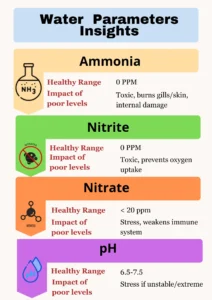A Healthy Betta is a Happy Betta
No matter how strong one is, failing to take preventive measures will lead to illness sooner or later. The same is true for betta; despite their hardy nature, these beautiful creatures are susceptible to various diseases affecting their health and well-being.
Once you purchase a betta fish from the store, it’s better to prevent disease before it occurs rather than wait for it to develop and then resort to treatment. It’s wise to prepare for potential ailments as soon as you buy your betta fish. Sometimes, it can be difficult for new betta owners to diagnose diseases. However, as you become more familiar with your betta’s behavior over time, it will become much easier to detect illnesses at an early stage.

You must understand the most common betta fish diseases and their timely diagnosis and treatment to keep your aquatic friend happy and healthy. This strategy will save your pet from potential damage and severe health conditions.
However, if your betta unfortunately suffers from the disease, there’s no need to worry or feel confused, as it will not solve your problem. Having raised hundreds of betta fish, we know thoroughly about almost every disease they can suffer. In this comprehensive guide, we have clearly explained the common ailments afflicting bettas, how to recognize their early symptoms, and how to combat these diseases.
Understanding Betta Health and Susceptibility
Bettas are prone to issues like stress and illness due to sensitive genetics, environmental changes, and improper care. You can play with the last two factors; however, bettas with genetic disorders are difficult to keep for a long time. Therefore, one should look for genetic issues before purchasing it. Early detection is crucial—spotting problems early greatly improves recovery chances.
Watch your betta daily; changes in swimming, eating, or appearance often hint at early disease. A clean, stable environment with proper temperature, filtration, and enrichment plays a vital role in keeping your betta healthy and stress-free.
Signs of Sick Betta Fish
If you notice one of the following signs, there could be something wrong with your betta. Observe closely your fish to look for these symptoms.
- Lethargy: Betta lying at the bottom of the tank or hiding more than usual indicates illness.
- Clamped fins: A sick betta holds its fins close to its body rather than fanned out, indicating a classic sign of discomfort and stress.
- Color change: Betta is losing its fin colors and looking pale and dull; there are signs of sickliness.
- Loss of appetite: If your betta refuses its favorite delicious food and shows a significant decrease in appetite, it could be a sign of illness.
- Labored breathing: If your betta is breathing heavily and gasping for air at the water’s surface, its gills might be affected.
- White spots: The dreaded white spots might look normal on a betta’s body, but they are a sign of parasitic infection.
- Abnormal swimming: An unusual swimming pattern like that of floating sideways or in circles and having difficulty staying upright can indicate a health problem.

Understanding these common symptoms will help you identify and diagnose a sick betta fish. It’s wise to take immediate action as soon as you notice these symptoms in your finned-friend. Failing to address this can have serious health consequences.
Step-by-Step Guide to Combat the Disease
1. Betta First Aid: What to Do Immediately
As soon as your betta shows signs of illness, take quick action. First, recognize the most apparent symptoms, like what the problem is. It may be rapid breathing, clamped fins, white spots, or sudden inactivity. The crucial things to perform are a partial water change, checking and stabilizing the water temperature, and removing any uneaten food to prevent further contamination.
2. Quarantine the Betta
So far, you have only identified sick betta fish and not diagnosed a specific disease, which you will learn later in this section. Once you confirm your betta fish is sick, hurry up and quarantine it in a hospital tank. A hospital tank could be an emergency tank of small size, say 1-2 gallons. Arrange all the essentials like filter, heater, substrate, and other decor items in the hospital tank so that the condition of your betta fish does not deteriorate further.
3. Emergency Treatment (Salt Baths)
Hopefully, by now, you have inspected your betta fish for symptoms and started researching to diagnose it, but until then, don’t leave it to its mercy; instead, proceed with emergency treatment. The most recommended treatment for treating almost every disease is giving salt baths to your betta.
Aquarium salt creates an inhospitable environment for specific pathogens and parasites. It has antiseptic properties that reduce the risk of infection. It can retard the growth of bacteria and fungi that may cause betta health problems. Additionally, it has proven helpful in reducing stress and promoting the healing process.
How to Dose Aquarium Salt?
- Add one tablespoon of aquarium salt for 1 gallon of water.
- Don’t put all the salt at once; instead, pour it gradually into the tank to ensure its even distribution and complete dissolution.
- Monitor the fish’s condition after adding salt to the aquarium. If you notice any unusual betta behavior, reduce the salt concentration by making partial water changes.
- Ensure you use aquarium salt, not table salt, as they differ.
4. Start Treatment of Your Betta
If your betta recovers after salt treatment, it’s good news, and you are lucky that your betta fish condition was not severe. But if the result does not come in your favor, don’t panic; it’s normal. If you make the correct diagnosis of your betta fish disease, cheers. Now, it’s up to us. We will provide you with the treatment guidelines for each betta disease.
List of Prevalent Betta Fish Diseases
- Fin and Tail Rot
- Ich
- Velvet
- Dropsy
- Swim bladder
- Popeye
- Fungal infections
- Columnaris
- Constipation
- Gill Flukes
- Hexamita (Hole in the head)
- Eye cloud
- Tuberculosis
- Tumor
- Hemorrhagic Septicemia
1. Fin Rot
Fin rot–one of the most common bacterial infections in betta fish that affects the fin or tail of fish. A betta suffering from fin rot has frayed, ragged, or disintegrating fins, sometimes with red or black edges.

A suffered betta may exhibit behavioral changes like slowed swimming, lethargy, or sometimes a loss of appetite. The root causes of the disease are poor water quality, stress, and injuries.
To treat the affected betta: improve water quality, avoid fin-nipping tank mates, and provide smooth decor.
2. Ich (White Spot Disease)
A parasitic infection that primarily affects freshwater fish, specifically betta fish. Ich in betta fish can be identified by observing the white spots resembling salt grains on the fish’s body and fins. This appearance names it the white spot disease. The fish will also suffer rapid or labored breathing.
Ich is a curable disease but creates an uncomfortable situation for betta fish. That’s why fish may scratch against decor or other accessories to relieve the pain and get rid of the parasite.
Ich can be treated by increasing the life cycle of the parasite by raising the temperature of your betta tank. You do not have to treat the sick fish; instead, you have to treat the whole tank water, as parasites have poisoned the entire tank.
3. Velvet (Gold Dust Disease)
Velvet (caused by parasites like Oodinium pillularis or Piscinoodinium) is a parasitic disease in betta fish, often called gold dust disease because it makes the fish look like they’re covered in a fine, golden or rusty-colored powder.
Besides the dusty appearance, the fish has clamped fins, experiences rapid breathing, and scratches against objects. Velvet is harder to see than ich, leading to later detection in betta fish and making it more deadly and aggressive than ich.
It’s usually treated by:
- Medication specific for Velvet (often copper-based, use with care).
- Turning off tank lights can help (the parasite is photosynthetic).
- Slight temperature increase.
4. Dropsy
Dropsy in betta fish isn’t a disease itself — it’s a symptom of a serious internal problem, usually caused by a bacterial infection affecting the fish’s organs (especially the kidneys). This infection leads to fluid buildup inside the body, making the fish swell up and look bloated. In advance cases, scales may stick out like a pinecone and the betta experience lethargy, or loss of appetite.
The causes of dropsy include:
- Poor water quality
- Stress or injury
- Weakened immune system
- Underlying organ failure or severe bacterial infection
Dropsy is often fatal if not treated immediately. It’s usually a late-stage symptom, meaning the fish has been sick for a while before the swelling appears. Treatment involves isolating the betta, improving water conditions, using antibiotics, and sometimes aquarium salt. However, recovery is difficult unless caught very early.
5. Swim Bladder Disorder (SBD)
Clear from the name — swim bladder disorder in betta fish occurs when the bladder stops functioning properly. Remember, the said organ helps the betta fish control its buoyancy.
The fish needs a properly working bladder to stay upright and swim normally. When the organ becomes damaged, this condition is called swim bladder disease.
When you notice difficulty swimming in your betta fish, such as sinking, floating uncontrollably, listing to one side, or inability to stay upright, it confirms that your fish is suffering from swim bladder disorder.
Constipation (most common), overfeeding, poor diet (pellets swelling too much), bacterial infection, and physical injury are the primary reasons that lead to swim bladder disease.
Swim bladder is usually not fatal and can be treated by ensuring the following things:
- Fasting for 2-3 days.
- Feeding a blanched pea (skin removed) or daphnia (if constipation is suspected).
- Epsom salt baths (can help reduce swelling).
- Identifying and treating underlying causes (e.g., bacterial infection).
6. Popeye (Exophthalmia)
A condition where one or both eyes of betta fish noticeably bulge outwards, referred to as popeye. The eye may look cloudy, puffy, or bloody, depending on how bad it is. It’s often a symptom of underlying issues—bacterial infection, internal parasites, injury, or poor water quality. Injury of one eye denotes a physical injury, while that of both eyes represents infection, usually due to poor water quality.
Its treatment involves:
- Addressing underlying cause – improve water quality.
- Antibacterial medication.
- Epsom salt baths can help reduce swelling.
- Ensuring safe tank decor to prevent injury.
7. Fungal Infections
A fungal infection in betta fish happens when a fungus (usually Saprolegnia or similar species) attacks the fish already weakened by poor water quality, stress, or injury. It looks like white cotton patches that grow on the skin, fins, gills, or mouth of your fish.
Fungal infection is treated as follows:
- Improve water quality.
- Give salt baths to your betta as they help relieve stress and boost fish healing ability, but they won’t “cure” Saprolegnia directly or in safe doses.
- Dose antifungal medication like Ich-X (formalin + malachite green).
8. Columnaris (Mouth Fungus)
Despite the name mouth fungus, it is actually a bacterial infection, not a fungus that affects betta fish, typically involving the mouth, gills, and fins. It’s caused by the bacterium Flavobacterium columnare, often triggered by poor water quality, stress, or high temperatures. Be warned; it’s highly contagious.
It’s challenging to recognize Columnaris in betta fish as it often looks similar to a fungal infection. A fungal infection appears as a fluffy, cotton-like patch, while Columnaris tends to look wispier or thread-like.
Aggressive treatment is needed to combat Columnaris. Its treatment options include:
- Antibiotics specifically targeted at Columnaris, like Furan 2 or Kanamycin
- Increasing water temperature (to around 78–80°F) to boost the immune system and slow bacterial growth
- Salt baths and isolating the infected fish in a hospital tank to prevent spread
- Improving water quality by ensuring proper filtration and water changes
Table of Betta Diseases for Your Easy Understanding
| Disease | Causes | Symptoms | Treatment |
| Fin Rot | Poor water quality, bacterial infection | Torn, ragged fins, fin discoloration | Improve water quality, use antibacterial medication |
| Ich (White Spot) | Parasite (Ichthyophthirius multifiliis) , frozen live food | White spots on body and fins, rubbing against objects | Raise water temperature, use ich treatment medication |
| Velvet | Parasite (piscinoodinium) | Gold or rust-colored dust on body, clamped fins | Dim lights, use copper-based medication |
| Dropsy | Bacterial infection, organ failure | Swollen body, pinecone-like scales sticking out
|
Isolate infected fish, use antibacterial medication, Epsom salts |
| Swim Bladder Disease | Overfeeding, poor water quality | Difficulty swimming, floating, sinking | Fast fish for 24-48 hours, feed skinned peas |
| Popeye | Bacterial infection, poor water quality | Swollen, bulging eyes (single or both) | Improve water quality, use antibacterial medication |
| Fungal Infections | Poor water quality, secondary to injuries | Cotton-like growths on previously damaged areas | Improve water quality, use antifungal medication |
| Columnaris | Bacterial infection (Flavobacterium columnare) | White spots, cotton-like patches, frayed fins | Isolate infected fish, use antibacterial medication |
| Anchor Worms | Parasitic infection (Lernaea) | Visible worms on body, red spots | Remove worms manually, use antiparasitic medication |
| Gill Flukes | Parasite (Dactylogyrus) | Gasping at surface, inflamed gills | Use antiparasitic medication |
| Other Disorders | Loss of color | Stress, Poor Water Quality, Various Diseases | Test water parameters, observe behavior |
| Sitting at the bottom | Lethargy, Stress, Various Diseases | Check temperature, water quality, recent changes | |
| Loss of appetite | Various Diseases | Observe other symptoms, check temperature |
Preventative Care: The Best Defense
The best approach is to take preventive measures to minimize the chances of getting your fish sick. Below are some of the most adapted and recommended steps to take:
- Regular water changes: Perform regular water changes using dechlorinated, temperature-matched water. It helps remove nitrates and waste and keeps the water parameters stable.
- Avoid overfeeding: Avoid overfeeding as it can lead to waste buildup, bloating, and swim bladder disease (SBD), all of which can harm your betta.
- Quarantine fish: Always quarantine new fish or live plants before introducing them to your main tank. It helps prevent introducing diseases or parasites that could harm your betta.
- Test water parameters: Test water parameters regularly, as it helps detect any issues with water parameters before they become harmful to your betta fish.
To provide a stress-free environment and keep your betta happy and healthy, read our comprehensive guide on betta fish care.
Optimum Range of Water Parameters
When to Consult an Aquatic Veterinarian
If you are unable to control the disease and the situation continues to worsen, it’s time to consult a veterinarian. You should seek out an aquatic veterinarian when the following occurs:
- Recognizing symptoms beyond home treatment
- Severe or rapidly worsening symptoms
- Lack of improvement with home treatment
- Diagnosing unusual or complex issues

